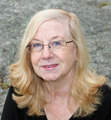Lea Wait's Blog, page 112
May 12, 2021
THANKS, MOM
I’ve posted this before, so I hope you don’t mind seeing it again. Yes, I know Mother’s Day was last Sunday but this is my day so I’m having my say. I have my mother to thank for introducing me to mystery novels.
[image error]We seldom agreed on much, but shared the love of a good mystery. My parents were avid readers and regular patrons of the public library. My father preferred historical and science fiction novels but my mother read exclusively mysteries. We made weekly trips to the library, where she got me started with Nancy Drew. Here was a detective who was sharp, adventurous, and female. Who knew? And I really wanted a car like Nancy’s roadster.

Years later, I was shocked to learn not only that Carolyn Keene wasn’t the author’s name but she hadn’t even written all the series’ books. Several authors contributed but Mildred Benson wrote 23 including the first three. I researched her for one of my books and learned Mildred was a journalist and a bit of an adventurer like her fictional character, even getting lost on an Amazon expedition.
[image error]
After going through all the mysteries for young adults, I switched to the books my mother read, Erle Stanley Gardner’s Perry Mason series and Agatha Christie’s wonderful Miss Marple and Hercule Poirot. My only disappointment in Perry Mason was the lack of romance, a trend that sadly continued on television.
[image error]
Finally, I discovered the beginnings of the romantic suspense subgenre with Mary Stewart’s and Phyllis Whitney’s books that blended romance and suspense along with the mystery. Still, their heroines too often put themselves in danger and had to be rescued by the hero. Thankfully today mystery novels have evolved as have their female characters, whether written by a man or a woman. Many of today’s heroine sleuths are as sharp and tough and adventurous as Nancy Drew, sometimes more so.
So thanks, Mother, for directing me toward the reading that would lead to what I’m doing today, blending romance, suspense, and mystery in my writing. If you’re still reading settled on your heavenly cloud, maybe you’ve picked up one of my books.
May 11, 2021
Writing In The Age Of A Waning Pandemic
It’s been a difficult year for everybody dealing with the COVID crisis and trying to maneuver through all the various roadblocks facing us, some of which include health concerns, financial worries and social isolation. It’s been difficult for writers, as well. Telling stories is hard when you’re concerned about the health of yourself and your loved ones.
As a working writer, the pandemic hurt me in a lot of ways. And yet in others ways it also helped me, too. I had a novel come out last April with readings and appearances set all around New England. Then the pandemic hit and all my readings and signings got canceled. All the bookstores and libraries closed and the hardcover sales of my book suffered because of it. My previous novel got nominated for the Maine Literary Award, but because of the pandemic the ceremony had to be held on Zoom. It was a bummer that myself and fellow other writers couldn’t meet up once a year. Making matters worse, my writers group had to do Zoom meetings instead of meeting at the pub.
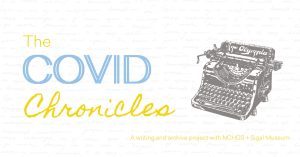
But on the plus side, there was nothing else to do but write. Bars and restaurants had closed down. The only place I could visit was the supermarket, and that added to my COVID weight gain, which I’ve since shed. I wrote a lot. In the process, I began the arduous path of reinventing myself—yet again. I’ve gone through many iterations as a writer and am now morphing again thanks to the COVID. It made me reevaluate everything and decide on where to go next.
As a writer, I wonder how much the COVID will appear as a background in the novels written by other authors. Will setting a novel in the time of the Pandemic date a work or enhance it? I’ve been hesitant to use it in my writing, fearing it might take away from my plot. But others might feel differently. Others might feel that the COVID crises could play a crucial role in their story and help in the development of their characters. And I can see how that might happen. Think of all the misdeeds characters could pull off while wearing a mask. It could also add depth and relevant social commentary.
I haven’t used the Pandemic yet in my stories, but that’s not to say I won’t in the future. It seems to me more fitting for an apocalyptic tale than a crime novel, but that could all change the more I look back and think about this period in my life. I’m interested to see how others integrate this chapter of history into their works.
In the meantime, as everyone gets vaccinated and society starts to slowly return to normal, I’m at my desk busy reinventing myself yet again. Changing, growing and trying to be a better writer. Trying to keep the weight off, go to the gym, eat better and keep myself healthy. I’m also constantly thinking about how my stories will play out and how my future characters will develop in new and unique ways. I hope everyone out there stays healthy so we can all get together one day and celebrate life—and living.
Be good, everyone.
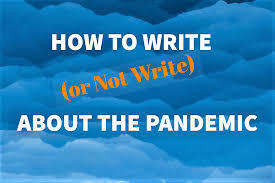
May 10, 2021
Cover Story
John Clark playing around with cover possibilities for several YA books. What do you think?

What happens when a somewhat shy teenager discovers an injured eagle, then finds out it’s really the god Thor who has been trapped by other jealous gods in the eagle’s body. Thor must have the boy and his newfound friend a female camp counselor from inner city Philadelphia cross into the mythic world and steal his hammer in order to be freed.
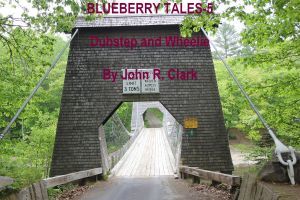
When an accomplished high school dancer loses use of her lower body when her horse is spooked by a partridge, her life seems bleak. Enter a Greek undergod in charge of dance who falls for her. When he caves under the pressure of her request to confront the gods on Olympus, she must find another way to approach to regain her mobility.
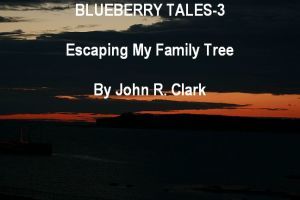
It’s a long way from the California coast to a stately home in Machias, Maine. Couple the journey with secrets your mother refuses to share, falling in love with an online photo in a yearbook and pursuit through the blueberry barrens by sinister associates of your estranged father and what do you do?
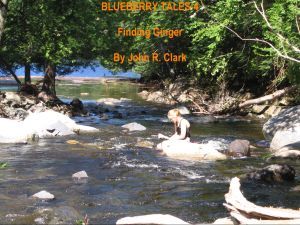
When a boy who lost one of his eyes because the family had no health care, discovers a stunningly beautiful girl eating from the dumpster behind the food court where he works, what sort of chemistry will happen? Ginger has run from the mental health treatment her well-meaning, but clueless parents keep imposing on her, but how will the growing romance between these two teens deal with her illness and another unexpected factor?
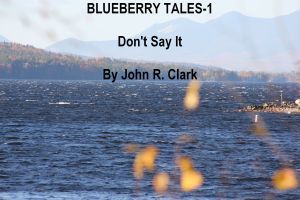
It’s 1969 and Marcy-Jo Parmenter is about to enter her senior year of high school. Frustrated by how girls and women are treated, her life seems pretty confined, but when she meets Robin, a most unusual guy at her Saturday evening AA meeting, it’s just the beginning of an odyssey that will involve high school rebellion, buying a blueberry field, supernatural visits with her deceased grandmother and an initially frightening discovery that ends up sending her on a completely unexpected path.
May 7, 2021
Diving into the Shallow End
The interesting thing about growing older is eventually you realize there’s a lot of stuff you just don’t know. (We won’t mention all the things you’ve forgotten.) One of my greatest regrets? I never took any history classes in college. Perhaps it’s a mercy; I might have fallen asleep memorizing dates and kings and battles, and it might have killed my curiosity forever.
I’m dimly aware from high school German class, of all places, that the Hundred Years War really lasted 116 years, and was broken into three main conflicts. But I’ll be damned if I can understand the convoluted interrelationships of the English and French dynasties, even with a helpful family tree. Throw in the Black Death and Joan of Arc, and I’ve got the mother of all headaches. It’s a mystery to these modern eyes.
I believe there’s a more integrated approach since my school days—if you’re studying the 1940s, for example, you’re probably reading popular fiction of the day and watching movies and newsreels, reading from primary source newspapers and magazines. You might even learn to swing dance and listen to Benny Goodman.
Obviously, World War II overshadows everything. Since time travel only appears in fiction (so far), the way to really understand a period is to immerse yourself in popular culture as deeply as possible, and it’s a little more accessible for us than going back to the Middle Ages and reading chivalric poems. There is a plethora of readily available information. Documentary series like Wartime Farm (highly recommended, even if you’re not a farmer or into World War II) give a taste of what it was really like for the “average” person.
I’m now writing books set in the 1920s in Britain. I’m American, old, but not 100. Yet. Sure, I’ve read Fitzgerald, Hemingway, and Evelyn Waugh. I’ve watched silent films, and listened to original recordings of early jazz. World War I may technically be over, but as we know, there was much unfinished business, so I’ve become inexpert on its influence on the following decade. I can’t pretend I’m a real scholar, and I confess I am far more beguiled by rising skirt lengths than the grim and grisly Battle of the Somme.
There. I’ve said it. I’m superficial. I want to know what people looked like. What they ate. What they bought. How women organized their homes and presented themselves in public, and what the freedom from corsets portended for the future. Clothes may make the man, but frocks from Chanel and Callot Soeurs are much more fun. And a good Hoosier cabinet was a modern miracle of practicality.
I do a lot of research online, but I own precious physical research books I can lose myself in for hours. Drawing rooms, gardens, cars, hair, hats, makeup, shoes—yes, please. My latest purchase harkens back to one of my favorite childhood pastimes—a paper doll book with illustrations from actual dresses of the era. I wouldn’t dream of cutting into it, and wonder which of the designs would suit my heroine.
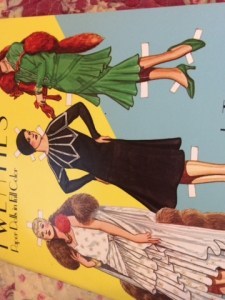
Does all this mean I ignore food rationing (sugar was limited until 1920 in Britain), police corruption (rampant), poverty (also rampant), or racial injustice (the more things change…)? Not at all. Do I spend pages describing each sequin and feather and polished silver fish fork? Again, no. But it helps to visualize my characters moving about their homes, and what possessions might be meaningful to them.
Are you a historical mystery reader? If there was time travel, what decade would you pick to explore?
Maggie Robinson is a former teacher, library clerk, and mother of four who woke up in the middle of the night, absolutely compelled to create the perfect man and use as many adjectives and adverbs as possible doing so. A transplanted New Yorker, she lives with her not-quite perfect husband in Maine, where the cold winters are ideal for staying inside and writing historical mysteries and romances. A two-time Romantic Times Reviewers’ Choice nominee, her books have been translated into French, German, Portuguese, Turkish, Russian, Japanese, Thai, Dutch and Italian. Maggie is a member of Sisters in Crime and Maine Romance Writers.
May 5, 2021
How a Post-Pandemic Road Trip is like Writing a Book
This past weekend my spouse and I set doubt and fear aside and took a road trip.

Like many others who live distant from kin, it had been a too long since we’d seen our families in person. We kept to ourselves here in Maine for the duration, visited with dear ones on Zoom and Zoom alone. As we waited through the winter months for our vaccination numbers to come up, we planned our first foray into the world beyond the Piscataqua River bridge.
Over nearly 20 years, we’ve traversed the highways to Massachusetts and Philadelphia many, many times. But after Covid-19 turned routine chores like grocery shopping into tactical missions, we found ourselves a bit anxious about staying safe. Friends who’d driven back and forth to Florida shared their strategies. We read a bunch of stories on the internet. Eventually we devised what seemed like a solid plan.
We took along food and water so as to avoid entering stores along the way. We did our homework about which hotels live up to their sanitizing promises. A specific tote bag was set aside for disinfecting products, masks, gloves and hand sanitizer. We stopped for fuel either where we could use a card at the pump or where an attendant fills the tank for you (e.g., at the throwback full-service plazas on the New Jersey Turnpike.)
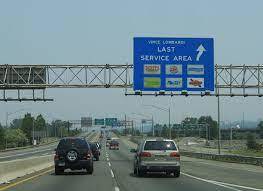
Still, it felt a bit intimidating to head out into a world still being rocked by the pandemic, through places where so many people have died and so many still are falling ill, where many fewer people are fully vaccinated than here in leads-the-nation-in-jabs Maine.
In the end, it was fine. A wonderful trip, in fact. Our preparation served us well. While I suppose something unexpected could have happened, we came to realize we were safe and pretty much in control of the experience.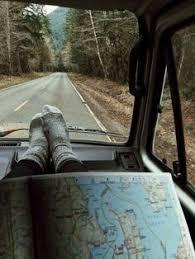
Sunday afternoon, as we drove through (interminable) Connecticut, I found myself ruminating about how a post-pandemic road trip was similar to writing a book. (How many of you wondered if I’d get around to talking about writing?)
Before I wrote my first novel, I worried about everything there was to worry about, and a few more things besides. Would Joe Gale and his friends and enemies who were so vivid in my mind come alive or be cardboard characters on the page? Was the plot I’d crafted in my head enough to hold readers’ interest for 350 pages? Would the process of writing hold my interest for 350 pages? Assuming I finished the book, could I trust my friends to tell me if it was deadly boring, or would they lie and tell me it was terrific? If the latter, how would I find people to read it and tell me the truth?
Preparing to write my first book was in many ways similar to gearing up for our recent road trip. I read and read and read the work of good crime writers. I took a few classes and went to a bunch of conferences, which allowed me to meet other writers who had published books. When I asked for their advice they were invariably generous with their knowledge and experience.
I took a few classes and went to a bunch of conferences, which allowed me to meet other writers who had published books. When I asked for their advice they were invariably generous with their knowledge and experience.
Once I had my doubt and fear under control, I committed to a writing routine that complimented my day job. It turned out to have two basic elements: (1) park butt in chair as often as possible and (2) write.

One of my writing spaces.
I hope the readers of this blog who are contemplating starting their own writing journey take this as encouragement. If you do the necessary prep work, you can go anywhere you want to go.
My advice: First, read a wide variety of writers. Reading deeply makes you a better writer.
Second, treat yourself to craft books like Stephen King’s On Writing or Anne Lamott’s Bird by Bird, but don’t overlook the contributions of MCW’s own Kathy Lynn Emerson. If history is your thing, her How to Write Killer Historical Mysteries is a treasure trove of information, and her marvelous new essay collection, I Kill People for a Living, is full of great advice.
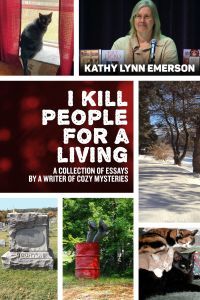
Kathy Lynn’s new book of essays. Lots of gold to mine here.
More information on Kathy Lynn’s books can be found at http://www.kathylynnemerson.com/
Third, look for classes and writing groups in your community. If you live here in Maine, the Maine Writers & Publishers Alliance is a great resource, particularly its statewide Gather events. Go here for more info: https://www.mainewriters.org/gather.
If mystery/crime is your genre, you might join the local chapter of groups like Sisters in Crime https://sincne.clubexpress.com/ and Mystery Writers of America https://mwane.org/ both of which offer connection, community and a variety of other benefits including craft classes, many of which are offered online.
Fourth, consider attending writing conferences, a fabulous place to meet other writers and learn about the business. Here in Maine we’re looking forward to Maine Crime Wave in June (see the schedule and sign up here: https://www.mainewriters.org/maine-crime-wave ). And in November, the New England Crime Bake will take place in Massachusetts (probably hybrid this year, so you can go in person or participate virtually). FMI: https://crimebake.org
But like our recent road trip, after all that careful preparation you need to start your engine and go. You don’t need a cooler or a road trip playlist for this journey. There are no shortcuts, and no alternate routes. Just park your butt in a chair as often as possible, and write.

Brenda Buchanan is the author of the Joe Gale Mystery Series, featuring a diehard Maine newspaper reporter who covers the crime and courts beat. Three books— QUICK PIVOT, COVER STORY and TRUTH BEAT—are available everywhere e-books are sold. These days Brenda’s hard at work on new projects.
May 4, 2021
It’s Win an ARC Wednesday
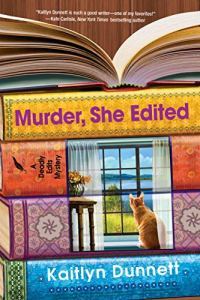 Would you like to win an Advance Reading Copy of the fourth Deadly Edits Mystery? All you have to do is leave a comment here to be entered in a drawing to be held May 15. Murder, She Edited (publication date: July 27) takes retired teacher turned book doctor Mikki Lincoln on a new adventure, this one centered around her inheritance of a long-abandoned farm not far from her home in Lenape Hollow. There’s a catch to claiming the land. Mikki has to find and edit diaries left behind by a former owner. Just to complicate matters, Mikki has acquired a stalker—a reader who (wrongly) blames mistakes in her favorite author’s latest novel on Mikki’s editing. As usual, Mikki’s calico cat, Calpurnia, is front and center as the story unfolds.
Would you like to win an Advance Reading Copy of the fourth Deadly Edits Mystery? All you have to do is leave a comment here to be entered in a drawing to be held May 15. Murder, She Edited (publication date: July 27) takes retired teacher turned book doctor Mikki Lincoln on a new adventure, this one centered around her inheritance of a long-abandoned farm not far from her home in Lenape Hollow. There’s a catch to claiming the land. Mikki has to find and edit diaries left behind by a former owner. Just to complicate matters, Mikki has acquired a stalker—a reader who (wrongly) blames mistakes in her favorite author’s latest novel on Mikki’s editing. As usual, Mikki’s calico cat, Calpurnia, is front and center as the story unfolds.

Kathy Lynn Emerson/Kaitlyn Dunnett has had sixty-three books traditionally published and has self published several children’s books and three works of nonfiction. She won the Agatha Award and was an Anthony and Macavity finalist for best mystery nonfiction of 2008 for How to Write Killer Historical Mysteries and was an Agatha Award finalist in 2015 in the best mystery short story category. She was the Malice Domestic Guest of Honor in 2014. Her next publication (as Kaitlyn) is the fourth book in the contemporary “Deadly Edits” series (Murder, She Edited), in stores in August 2021. As Kathy, her most recent novel is a standalone historical mystery, The Finder of Lost Things. She maintains websites at www.KaitlynDunnett.com and www.KathyLynnEmerson.com. A third, at A Who’s Who of Tudor Women, is the gateway to over 2300 mini-biographies of sixteenth-century Englishwomen, now available in e-book format.
What Do You Know About Rhubarb?
Kate Flora: I’ve been busy in the gardens, weeding, rearranging plants, and evicting invasives, so today I thought I would share one of my late mother, A. Carman Clark’s, columns with rhubarb lore and recipes. This was originally a column in The Camden Herald and later included in her essay collection, From The Orange Mailbox.
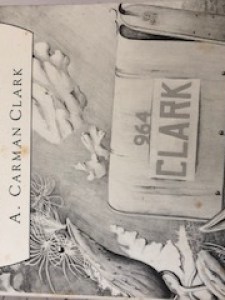 We know that spring has really come to the Georges River valley when there are two rhubarb pies for dinner–the traditional old-fashioned kind flavored with a bit of grated orange peel and our own Sennebec Hill rhubarb custard pie with a sprinkling of fresh ground nutmeg.
We know that spring has really come to the Georges River valley when there are two rhubarb pies for dinner–the traditional old-fashioned kind flavored with a bit of grated orange peel and our own Sennebec Hill rhubarb custard pie with a sprinkling of fresh ground nutmeg.
Before this, when the first pink shoots appear, we enjoy sunny hours remulching the twenty-seven hills of rhubarb and adding fertilizer for the coming year. The winter’s accumulation of magazines and newspapers are lavishly spread between the rows; handfuls of a 5-10-10 commercial fertilize are scattered about to speed the breakdown of the paper; and the whole plot is covered heavily with bales of hay that banked the farmhouse during the winter. One pail of well-rotted manure dumped on each hill and we are ready for another year–a year of eating, freezing, selling, and inventing new recipes to use up the indefatigable bounty of rhubarb.
New England provides the ideal climate for growing rhubarb, and according to John Lowell, one of the founders of the Massachusetts Horticultural Society, it was a Maine gardener who introduced rhubarb into America as a food plant. The history of rhubarb covers almost forty-seven centuries, going back to 2700 b.c. in China. Cultivated as a medicine for use as a purgative and a gastric tonic, roots at least five years old were sliced, dried, and then powdered. Early travelers carried the plant from China to Persia, Greece, and Russia; it was grown in the early botanical gardens at Padua, Italy, taken to England and Scotland, and then to America.
The garden journals of George Washington, John Jay and Thomas Jefferson record their planting of rhubarb, and in 1770, Benjamin Franklin sent rhubarb seeds from Scotland to his botanist friend, John Bartram. But it wasn’t until about 1780 that recipe books began to mention its use in tarts and pies. Probably because sugar was a scarce commodity in rural New England, it was after 1800 that rhubarb gained the Yankee name “pieplant.” Brides going forth to newly cleared acres took along a crock of sourdough yeast, a few cuttings of lilac, and a clump of rhubarb roots. Lewis and Clark carried powdered rhubarb root on their journey of exploration to the Pacific.
While icy northern winters killed fruit trees, the pieplant seldom failed to furnish the first fresh food each spring. Out on Matinicus Island, a clump set out by Iddo Tolman in 1858 is still growing, requiring only occasional fertilizing to nourish the crisp, tart stalks that are one of the culinary joys of the spring season.
Rhubarb seeds need to be planted in a place apart, where it will not be disturbed for years, and it needs full sun for at least half of each day. Healthy, well-fed rhubarb is a handsome plant and when set against a stone wall or the base of a shed or barn, the great spreading leaves fan out like rainforest vegetation. Rows of rhubarb can be set as a border between lawn and garden.
It isn’t necessary to be fussy. The quickest way to start a bed is to beg a few roots from a neighbor. Since the plants need to be divided or thinned every six years, most rhubarb growers will cheerfully give you enough to start your hills.
The roots should be dug and divided before the first leaves begin to uncurl in May. Spade  up a clump and hose away the soil so you can easily cut the root mass apart, leaving one bud on each division. Plant the roots three feet apart with the buds set about two inches below the soil surface. Because a rhubarb bed is usually a lifetime investment, the roots should be set in good loam enriched with compost and old manure. But because rhubarb is such a hardy plant it will do well in almost any soil as long as there is good drainage and as long as it is fed annually with plenty of old hay or compost. Many rhubarb growers feed their plants by dumping kitchen scraps–peeling and other compost material–right under the spreading leaves.
up a clump and hose away the soil so you can easily cut the root mass apart, leaving one bud on each division. Plant the roots three feet apart with the buds set about two inches below the soil surface. Because a rhubarb bed is usually a lifetime investment, the roots should be set in good loam enriched with compost and old manure. But because rhubarb is such a hardy plant it will do well in almost any soil as long as there is good drainage and as long as it is fed annually with plenty of old hay or compost. Many rhubarb growers feed their plants by dumping kitchen scraps–peeling and other compost material–right under the spreading leaves.
There’s a local story about about a coastal farmer who once asked a neighbor for enough rhubarb for a bit of sauce. Upon being told there was none to spare, the farmer promptly went out and acquired enough roots to plant a 200 foot row. He allowed as how no one would ever ask him for a mite of rhubarb without being generously provided. Years later, when a younger man took over the farm, the roots needed dividing. With true Yankee ingenuity, he drove his plow straight down the middle of the whole row, split the plants in half, transplanted one half, and ended up with two 200 foot rows.
I once read that farmers in Afghanistan cover their rhubarb with several feet of gravel so that by the tie the shoots have struggled up through this, they are pale and very tender. By placing a chimney tile over one of my plants and pouring several pails of sand inside, I have produced a reasonably accurate facsimile of this method and found the stalks far more delicate than those of the usual plant. Another year I discovered a way to produce earlier rhubarb: placing an open-ended barrel over one hill and mounding manure up around the outside of it. I got tender ruby stalks weeks ahead of the rhubarb in the open field.
The best rhubarb for cooking, canning, or freezing comes from the long tender stalks of well-fed roots pulled between May 1 and July 4. After that, the skin gets tougher (although a well-mulched bed will produce good stalks for pie as late as August). One of our favorites is blu-barb pie, half blueberries and half rhubarb, invented in 1962 for the Maine Blueberry Festival.
Although rhubarb is a vegetable, it is generally used as a fruit–naturally enough since it is in season in spring when fresh fruits are scarce. Because it’s easy to freeze, it can provide a variety of desserts all through a winter.
Rhubarb should be pulled, not cut. Stalks should be be twisted sideways and pulled at an angle. Snip the leaves and the base of the stems onto the mulch around the plants. To freeze rhubarb, wash, dry, cut into half-inch pieces, spread on a cookie sheet and freeze, the move into double plastic bags.
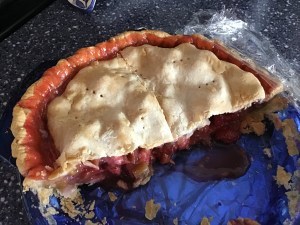 Old-timers around this part of Maine (mid-coast) claim that rhubarb has a tranquilizing effect and surely almost anyone would agree that a flaky-crusted rhubarb pie can exert a calming effect at the end of a working day. But rhubarb is versatile and can be used in many ways.
Old-timers around this part of Maine (mid-coast) claim that rhubarb has a tranquilizing effect and surely almost anyone would agree that a flaky-crusted rhubarb pie can exert a calming effect at the end of a working day. But rhubarb is versatile and can be used in many ways.
Sennebec Hill Rhubarb Pie
Beat together:
1 1/2 c. sugar
2 eggs
1/2 t. nutmeg
2 T. butter
1/4 c. flour
1/2 t. salt
Stir into this 3 cups chopped rhubarb. Pour into pie crust, add top crust, and bake 10 minutes at 450, then 40 minutes at 350.
Blue-Barb Pie
Mix together:
1 c. sugar
1/4 c. flour
1/4 t. salt
1 1/2 c. rhubarb cut in small pieces
1 1/2 c. blueberries.
Dot with bits of butter and bake 10 minutes at 450 and 30 minutes at 350.
Strawberry Rhubarb Pie
Blend together:
2 c. rhubarb
2 c. sliced strawberries
1 1/4 c. sugar
1/4 t. salt
1/3 c. flour
2 T. butter
Bake as a two-crust pie at 450 for 10 minutes and 30 minutes at 375.
Rhubarb Flummery
4 c. cut rhubarb
1 3/4 c. sugar
stew gently for 10 minutes
8 slices of buttered white bread
Layer buttered bread and warm stewed rhubarb in a deep baking dish. Chill for 24 hours. Serve with whipped cream.
Rhubarb Cake
1/2 c. sugard
2 c. finely chopped rhubarb
Blend together and set aside:
1/2 c. butter
1 1/2 c. sugar
1 egg
1 t. vanilla
Mix together:
2 c. plus 2 T. flour
1 t. cinnamon
1 t. baking soda
1/2 t. salt
Add alternately to blended mixture with 1 c. buttermilk
Add rhubarb mixture
Add:
1/2 c. shredded coconut
1/2 c. raisins
1/2 c. chopped walnuts or pecans
Blend together. Pour into a greased and floured 7 x 12 baking pan. Bake at 350 for 45 minutes.
Sennebec Pudding
Mix together:
2 c. blueberries
1 1/2 c. rhubarb
1 t. tapioca
1 1/4 c. sugar
Put this mixture into a buttered 2 quart casserole.
Mix together:
1/2 c. sugar
1/2 c. flour
1/2 c. oatmeal
1/4 c. wheatgerm
blend in 1/4 c. butter
Spread over fruit mixture and bake 45 minutes at 350. Serve warm with ice cream
May 2, 2021
The Writer’s Life, 1977-1984
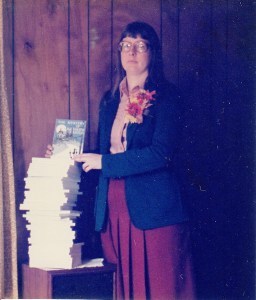
1985: my first author copies
Kaitlyn Dunnett/Kathy Lynn Emerson here. Recently I was rearranging some of the books in my office, including old record and day books, and randomly opened one of the earliest, the ledger I kept for the years 1977-1984. I started writing seriously—with the goal of being published and paid for it—when I finished my first and only year as a teacher of seventh and eighth grade English. It may have been called “Language Arts.” Whatever it was called, I was the newcomer. That meant I didn’t get to teach any of the top students. Although there were a few who were willing to learn, the vast majority were more interested in the opposite sex, sports, and goofing off. Worse, that year’s seventh grade class was disproportionately male, making it even harder for a twenty-something female teacher with not a single education course in her background to maintain control. How, you ask, did I even get hired? There had been a secondary baby boom (I was part of the first one) and the administration was desperate for warm bodies. Anyone with a college education was considered qualified to teach.
 My husband and I had bought a house on twenty-five rural acres in 1975. Newly unemployed and with no particular job prospects on the horizon in the fall of 1976, I decided it was finally time to stop talking about wanting to write a novel and actually do it. The fact that I didn’t know anything about what I was doing didn’t stop me. In fact, that was probably a good thing.
My husband and I had bought a house on twenty-five rural acres in 1975. Newly unemployed and with no particular job prospects on the horizon in the fall of 1976, I decided it was finally time to stop talking about wanting to write a novel and actually do it. The fact that I didn’t know anything about what I was doing didn’t stop me. In fact, that was probably a good thing.
That first year I wrote two long historical novels and started a third, all set in sixteenth-century England, and completed the rough draft of a nonfiction book about Tudor women. Since I recorded mileage as a business expense, I know that in 1977 I made many trips to libraries (Wilton Public, University of Maine at Farmington, Bates, Colby, and the Maine State Library) to do research. 331 miles in all. This was long before the Internet, although Inter-library loans were available. I was also running up a healthy postage bill sending queries to publishers. First class postage was thirteen cents, but it still mounted up. Sending an entire manuscript of 560 or so pages cost $2.90.
 My biggest expense in 1977 was a new typewriter, replacing my old portable with an Adler model 200. It cost $320 plus $16 sales tax. I was using medium white erasable typing paper ($8.40 a ream) with carbon paper. The only other option for making copies was the Xerox machine at the library, but that was even more expensive. Carbon paper cost sixty-nine cents a package. Typewriter ribbons went for $1.39 each. A note at the end of the year indicates I used seven reams of typing paper, seven ribbons, and five packages of carbon paper in 1977. I also spent $117.77 on buying books. My home library consisted of forty-two reference books and twenty “pertinent novels” at the end of 1977.
My biggest expense in 1977 was a new typewriter, replacing my old portable with an Adler model 200. It cost $320 plus $16 sales tax. I was using medium white erasable typing paper ($8.40 a ream) with carbon paper. The only other option for making copies was the Xerox machine at the library, but that was even more expensive. Carbon paper cost sixty-nine cents a package. Typewriter ribbons went for $1.39 each. A note at the end of the year indicates I used seven reams of typing paper, seven ribbons, and five packages of carbon paper in 1977. I also spent $117.77 on buying books. My home library consisted of forty-two reference books and twenty “pertinent novels” at the end of 1977.
1978 was more of the same. More big historical novels, revisions of what I’d already written, and a few short stories. Nothing sold, although I did occasionally get personalized feedback in rejection letters. This was before most writers’ groups were founded. It was still pre-computer. Just as an example, typing the final draft of one of the historicals (I don’t have a page count) took me sixteen days. Just typing. With a carbon copy. On a manual typewriter. And if I did any revising, the whole thing would have to be retyped. I kept the “good copies” in a fireproof safe when they weren’t being submitted.
In 1979, the final draft of my longest effort, a 785 page historical novel set in Colonial New England, took the longest time to type. I started on May 16 and didn’t finish until July 3. That was just typing. I wasn’t experienced enough yet as a writer to be doing much revising as I typed. I probably thought my deathless prose didn’t need any more tweaking.
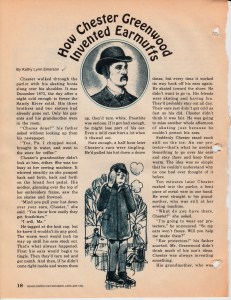 By 1980, postage had gone up to fifteen cents for a first class letter. That was the year I actually sold something. It was my nonfiction book about Tudor Women, but there was no advance and it wouldn’t be in print until 1984. My current e-book original, A Who’s Who of Tudor Women, is the much revised, expanded, and updated version of that book. It wasn’t until July of 1982 that I finally earned my “professional writer” credentials by selling a short story, “How Chester Greenwood Invented Earmuffs,” to Highlights for Children for a whopping $80.00. It was published in the January 1984 issue. In 1983 I sold my first novel, not one of those big historical stories, but a contemporary mystery for children ages 8-12. Again, there was no advance, and it was 1985 before it was in print from Down East Books. As with the nonfiction, I’ve recently reissued The Mystery of Hilliard’s Castle as an e-book (and in trade paperback).
By 1980, postage had gone up to fifteen cents for a first class letter. That was the year I actually sold something. It was my nonfiction book about Tudor Women, but there was no advance and it wouldn’t be in print until 1984. My current e-book original, A Who’s Who of Tudor Women, is the much revised, expanded, and updated version of that book. It wasn’t until July of 1982 that I finally earned my “professional writer” credentials by selling a short story, “How Chester Greenwood Invented Earmuffs,” to Highlights for Children for a whopping $80.00. It was published in the January 1984 issue. In 1983 I sold my first novel, not one of those big historical stories, but a contemporary mystery for children ages 8-12. Again, there was no advance, and it was 1985 before it was in print from Down East Books. As with the nonfiction, I’ve recently reissued The Mystery of Hilliard’s Castle as an e-book (and in trade paperback).
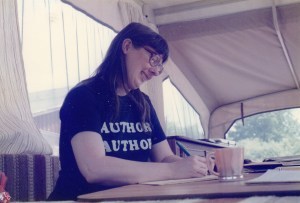 1984 was a banner year, with my first paid publication and my first published book coming out from a traditional (small, scholarly, but still . . . ) publisher. I also did my first paid gig as a writer, receiving an honorarium of $50 for leading a workshop at a local Young Author’s Conference. I edited my grandfather’s memoirs that year, but only for the family. It wouldn’t be until last year that I’d issue The Life of a Plodder as an e-book and trade paperback.
1984 was a banner year, with my first paid publication and my first published book coming out from a traditional (small, scholarly, but still . . . ) publisher. I also did my first paid gig as a writer, receiving an honorarium of $50 for leading a workshop at a local Young Author’s Conference. I edited my grandfather’s memoirs that year, but only for the family. It wouldn’t be until last year that I’d issue The Life of a Plodder as an e-book and trade paperback.
Looking back, it’s a wonder I persevered, but during those years I couldn’t not write. By the time the first book came out. I was still honing my skills, but I was also working as a library assistant at the University of Maine at Farmington’s Mantor Library to make ends meet. My husband, who never wavered in his support as a “patron of the artist” was a deputy sheriff, one of the most underpaid jobs around. It would have been nice to have written and sold a bestselling novel, but I can’t regret the way things have gone. I’m just glad technology soon advanced to the point where I didn’t have to pound out drafts on a manual typewriter anymore.

Kathy Lynn Emerson/Kaitlyn Dunnett has had sixty-three books traditionally published and has self published several children’s books and three works of nonfiction. She won the Agatha Award and was an Anthony and Macavity finalist for best mystery nonfiction of 2008 for How to Write Killer Historical Mysteries and was an Agatha Award finalist in 2015 in the best mystery short story category. She was the Malice Domestic Guest of Honor in 2014. Her next publication (as Kaitlyn) is the fourth book in the contemporary “Deadly Edits” series (Murder, She Edited), in stores in August 2021. As Kathy, her most recent novel is a standalone historical mystery, The Finder of Lost Things. She maintains websites at www.KaitlynDunnett.com and www.KathyLynnEmerson.com. A third, at A Who’s Who of Tudor Women, is the gateway to over 2300 mini-biographies of sixteenth-century Englishwomen, now available in e-book format.
April 30, 2021
Weekend Update: May 1-2, 2021
 Next week at Maine Crime Writers there will be posts by Kaitlyn Dunnett/Kathy Lynn Emerson (Monday), Kate Flora (Tuesday), Brenda Buchanan (Thursday) and Maggie Robinson (Friday).
Next week at Maine Crime Writers there will be posts by Kaitlyn Dunnett/Kathy Lynn Emerson (Monday), Kate Flora (Tuesday), Brenda Buchanan (Thursday) and Maggie Robinson (Friday).
In the news department, here’s what’s happening with some of us who blog regularly at Maine Crime Writers:
It’s Maine Crime Writers “Where Would You Put the Body” Spring 2021 edition. How do you enter? Send a photograph of your chosen spot to: WritingAboutCrime@gmail.com with “Where Would You Put the Body?” in the subject line and the photo’s location in the body of the email. There will be prizes for First, Second, and Third place–books of course and other Maine goodies. You may enter no more than three photographs, each one entered separately. They must be of Maine places and you must identify the place in your submission. Photos must be the submitter’s original work. Contest will begin May 1st and will run through June 15th.
An invitation to readers of this blog: Do you have news relating to Maine, Crime, or Writing? We’d love to hear from you. Just comment below to share.
And a reminder: If your library, school, or organization is looking for a speaker, we are often available to talk about the writing process, research, where we get our ideas, and other mysteries of the business. We also do programs on Zoom. Contact Kate Flora
April 29, 2021
The Hardest Part of Writing – MCW Authors Discuss
Today, we’re getting together as a group to discuss which aspects of the writing process are hardest. For different writers, different parts of the process are most challenging. For some, it is plotting, for others crafting memorable characters, and for others, it may be writing believable dialogue or choosing details to use in description or how much of an author’s research ends up in the final work. Feel free to chime in with your comments.
hardest. For different writers, different parts of the process are most challenging. For some, it is plotting, for others crafting memorable characters, and for others, it may be writing believable dialogue or choosing details to use in description or how much of an author’s research ends up in the final work. Feel free to chime in with your comments.
Kate Flora: I have been at this for about thirty-five years now, and so for me, different aspects present as my hardest challenges at different times and in different books. In the beginning, it was often how to nail my characters’ voices, and pay attention to the nuances of speech among men and women, older people and younger, the effects of different levels of education, and habits of particular characters. I had to learn (and often relearn) to shut up and listen. I tell my students that one good place to listen without seeming to be rude is store dressing rooms. (Not in the last year, of course) And for guys, who may not be chatty in dressing rooms, Dunkin’ Donuts, especially in mid-morning, is a great place to sip coffee and eavesdrop.
Sometimes, especially when I’m working on a thriller or a nonfiction book, pacing, or organizing the material in a way that will make it compelling and urge the reader forward is a challenge. There is always avoiding the sagging middle, and remembering that if what I’m writing bores me, it will likely bore the reader as well.
In the early years, I used to hate revision, and would start another book instead. Now I see revision as the chance to tie up those careless loose ends, improve the prove, make sure the plot and characters work, and find those damned places where a word is missing.
Maggie Robinson: What isn’t hard, LOL. I have great difficulty following any sort of outline, as my characters inevitably do not care for the path I originally chose for them. So they strike out, amidst much grumbling (theirs AND mine), on their own, with varying results. I used to think writers were crazy when they blamed their characters for willfulness, but 20+ books in, I’m crazy now too. Consequently, I am often surprised by the turn of events, and have to go back to “fix” things.
I love to write beginnings, but like a lot of people get mired in the mucky middle. I know if I feel I’m flagging, it will seem deadly to the reader, and I’m not talking about murder. So I have to remind myself that the second act should be just as much fun as the first, and lead logically to the third.
John Clark: The writing is easy. It’s everything that follows that’s the hard part for me. Lazy? Cowardly? Fear of Rejection…Who knows. I’ve got four books completed, but not edited in my Wizard of Simonton Pond series, An anthology of Ya stories about Maine kids, plus four more YA fiction titles in various stages of completion. At 73, however, the grim reaper sits atop my book case nodding and whispering “Time’s a’runnin out bubby, better get cracking if you want any of this drivel to see the light of day.”
Susan Vaughan: Like Maggie said, what isn’t hard! But I’ll choose one. Conflict. Conflict, as writers know, is what drives a story. Here’s an example of what doesn’t work. Bill needed a job or he’d starve and the gang would kill him. Bill got a job and then he was safe and fed. The End. Boring. You’d close the tiny book’s cover after a few pages. But suppose Bill struggles throughout the book, barely making it alive to the end. You’d want to know page after page how he fared.
 When I first began submitting to publishers, the rejections usually said the writing and the plot were good but there wasn’t adequate conflict. They meant the characters’ internal conflicts, their personal issues, not what I described for poor Bill. It wasn’t until I figured that out that I sold my first novel, which will be 20 years ago in June. And it hasn’t gotten any easier finding my characters’ inner demons and creating the plots to force them to face and deal with those demons. In my current project, Genuine Fake, Boyd blames himself for his Special Forces’ buddies’ deaths and believes he can’t be trusted to protect anyone. So I force him to be responsible for protecting Gemma, the woman he’s never forgotten and who asks him for help, because someone is trying to kill her. I hope I’ve made this work so readers will keep turning the pages.
When I first began submitting to publishers, the rejections usually said the writing and the plot were good but there wasn’t adequate conflict. They meant the characters’ internal conflicts, their personal issues, not what I described for poor Bill. It wasn’t until I figured that out that I sold my first novel, which will be 20 years ago in June. And it hasn’t gotten any easier finding my characters’ inner demons and creating the plots to force them to face and deal with those demons. In my current project, Genuine Fake, Boyd blames himself for his Special Forces’ buddies’ deaths and believes he can’t be trusted to protect anyone. So I force him to be responsible for protecting Gemma, the woman he’s never forgotten and who asks him for help, because someone is trying to kill her. I hope I’ve made this work so readers will keep turning the pages.
Kaitlyn Dunnett/Kathy Lynn Emerson: Yes, it’s all hard, but for me, right now, the hardest part is getting going again. I’ve taken a rather long break from doing any new writing. Although I’ve been revising older projects and self publishing them, that’s not the same thing as creating a new novel or short story from scratch. The longer I go without facing that blank screen, the harder it is to talk myself into committing myself to the long months of work involved in producing a novel. The idea of writing several proposals is even harder to face, since each one would involve an emotional investment in characters and their story with no guarantee any editor out there will be interested in the result. I’m past the point of trying to come up with something someone is “looking for” in order to make a sale. Whatever comes next has to be something I want to write.
Maureen Milliken: Writing is “hard” in that it takes a lot of attention to detail, mental energy and time. Often, those things aren’t fun. But if you really hate them, that’s going to be the hardest thing about writing and you may want to consider why you’re doing it. I’m not saying stop doing it, I’m just suggesting you consider whether you feel driven to write, or if you’re motivation is simply to be “a writer.” You can’t be one without doing the hard work. For many years, I was an editor in the Writer’s Digest self-published book contest and have read hundreds of self-published books. The number one issue (tied with really awful “editing”) is that people were submitting first drafts. They hadn’t done the work. I’m a writing dork, I guess, who actually enjoys the work. The hardest thing for me is finding the time to do it, with three jobs that keep a roof over my head.
Lea Wait's Blog
- Lea Wait's profile
- 506 followers


